The Best Pad Thai
This post may contain affiliate links. Please read the disclosure policy.
This Authentic Pad Thai dish has the perfect balance of sweet, sour and salty with classic pad thai flavor. It’s so much better than takeout and comes together in under 30 minutes.
This versatile Pad Thai recipe tastes great and can be adapted to your family’s taste. You can make Shrimp Pad Thai, Chicken Pad Thai, Tofu or vegetarian Pad Thai. You can also make it with an Instant Pot or meal prep it for on-the-go.
What is Pad Thai?
Pad Thai or Phad Thai means “Thai-style stir-fried noodles”, and it’s a popular noodle dish commonly served as street food in Thailand. It is the most popular dishes at Thai restaurants in the West.
Key ingredients include rice noodles, eggs, garlic, green onions, vegetables, shrimp, chicken or Tofu, red chili, sugar, tamarind paste, fish sauce, and usually served with lime wedges, chopped peanuts and cilantro.
Special Ingredients for Authentic Pad Thai
To make this authentic Pad Thai recipe, you will need some ingredients that might not be familiar to you. If you cannot find all of them, you can check Easy Shrimp Pad Thai recipe for a simpler version.
Thai Rice Noodles
These vermicelli noodles are thin, translucent noodles ranging from 1/8″ to 3/8″ wide. You can find them at Asian grocery stores or online, and I find 1/4″ width works best in this recipe.
Tamarind Paste
Tamarind paste is a common ingredient used in Thai, Indian and Mexican dishes. It is made from the pulp of tamarind pod (fruit of the tamarind tree). Tamarind paste is very sour and usually comes in a jar.
The potency varies widely, so you need to taste and adjust the quantity accordingly as you make the dish. Also, read the label to find out whether your paste is sweetened or not. If so, reduce the amount of sugar in the recipe.
You can find tamarind paste in many Asian grocery stores or online. If you’re looking for a tamarind paste substitute, use rice vinegar or lime juice mixed with an equal quantity of brown sugar.
Fish Sauce
Fish sauce is also an important ingredient for creating authentic pad thai flavor, and is a common ingredient in Southeast Asian cooking.
As it’s made from fermented anchovies, some people find the smell unappealing. However, the taste is amazing and you can find it readily available in Asian grocery stores. A good substitute is an equivalent amount of Worcestershire sauce or soy sauce.
How To Cook Thai Noodles?
Unlike most other noodles, Thai Rice Noodles don’t need to be boiled! Nonetheless it’s important to cook the noodles properly to get the perfect texture for this dish.
Step 1: Soak the Noodles
Soaking in cool water: Some directions on the package call for soaking them in cold or lukewarm water. It usually takes about 40 minutes in lukewarm water and about 1 hour in cold water.
Soaking in hot water: I find the best and fastest way is soaking in hot water. Bring a large pot of water to boil and remove it from heat. Then add the rice noodles and check every 3-5 minutes until noodles are soft but still al dente, usually after 5-10 minutes.
Step 2: Drain the Noodles
Make sure the noodles are tender but not too soft, flexible but not mushy. Drain the water.
Step 3: Add Oil
Drizzle one tablespoon vegetable oil over the softened noodles to keep them from sticking. Set them aside.
How to Make Pad Thai Sauce?
Homemade Pad Thai sauce is so much better than store-bought varieties, and it’s easy enough to make with substitutes if you can’t find all the ingredients. Make it once and you’ll never buy bottled Pad Thai sauce again.
In a small to medium bowl, mix together tamarind paste (start with 1 tablespoon), fish sauce, soy sauce and brown sugar. Mix well and taste. Add more tamarind paste gradually and look for the balance sweet and sour flavor.
Tips and Secrets for Making the Best Authentic Pad Thai
- When you make Pad Thai sauce, taste-test it to get a balance of sweet, sour and salty flavors.
- The secret to getting the perfect texture of noodles is to soak them in boiling water until it’s flexible but undercooked. As they will be fried with vegetables and shrimp later in the skillet or wok.
- Thaw the shrimp before adding to the skillet so that they can be cooked evenly.
- Don’t overcook the shrimp. Move to the next step as soon as they turn pink. This is important for sautéing shrimp.
- You can make this dish spicier by adding more chili sauce or chili flakes.
- If you plan to double the recipe, add the noodles in stages to make it easier to mix and cook the noodles.
How to Select the Right Shrimp? It’s best to buy frozen jumbo size shrimp that’s peeled and deveined with the tails on or off according to your preference.
How to Make Vegetarian Pad Thai? Substitute shrimp with vegetables and firm tofu, and then substitute fish sauce with soy sauce or Worcestershire sauce.
How to Substitute Tamarind Sauce? To substitute Tamarind Paste, you can use rice vinegar or lime juice mixed with an equal quantity of brown sugar.
How to Substitute Fish Sauce? You can substitute with an equivalent amount of Worcestershire sauce or soy sauce.
The Best Pad Thai
Ingredients
- 8 oz Thai rice noodles
- 1 lb raw shrimp , 21-25 or 26-30 size, peeled and deveined
- 4 tbsp vegetable oil, divided
- 2 cloves garlic, minced
- 1 fresh ginger, peeled and minced
- 3 large eggs
Pad Thai Sauce
- 1-3 tbsp tamarind paste
- 3 tbsp fish sauce
- 1 tbsp soy sauce
- 1/3 cup brown sugar
Topping ingredients
- 1/4 cup peanuts, crushed
- 1 lime
- 1/3 cup cilantro, chopped
- red pepper flakes, optional
- 1 lemon
- 1/3 cup cilantro, chopped
Instructions
- Bring a large pot of water to boil and then remove from heat. Add in rice noodles and check every 3 minutes until noodles are soft but still undercooked. (This is important as the noodles will be cooked more in the skillet).
- In a medium-sized bowl, add tamarind paste, brown sugar, soy sauce and fish sauce. Mix well to create the “Pad Thai” sauce. Taste the sauce and add more tamarind if needed. Look for sweet and sour flavor balanced with salty and spicy flavor.
- Heat remaining 3 tbsp oil in a large non-stick skillet over medium-high heat. Add garlic, ginger and white part of green onions and cook for about 1 minute. (Optional: Add red flakes)
- Add carrots and sauté for 2 more minutes.
- Push the mixture to the edge of the pan and add eggs to the center. Cook and scramble until eggs have cooked through.
- Add in bean sprouts and cook for 1 minute, and then add in shrimp and toss everything together and cook for about 3 minutes until shrimp turns pink.
- Then add noodles to and sauce mixture to the skillet. Toss everything together and combine well.
- Remove from heat. Squeeze fresh lime to taste along with peanuts, cilantro, more green onions. Serve and enjoy
Please read our nutrition disclaimer.
Looking for more shrimp recipes?
© TIPBUZZ. Images and text on this website are copyright protected. Please do not post or republish without permission. If you want to republish this recipe, please link back to this post. This post may contain affiliate links. Read the disclosure policy here.
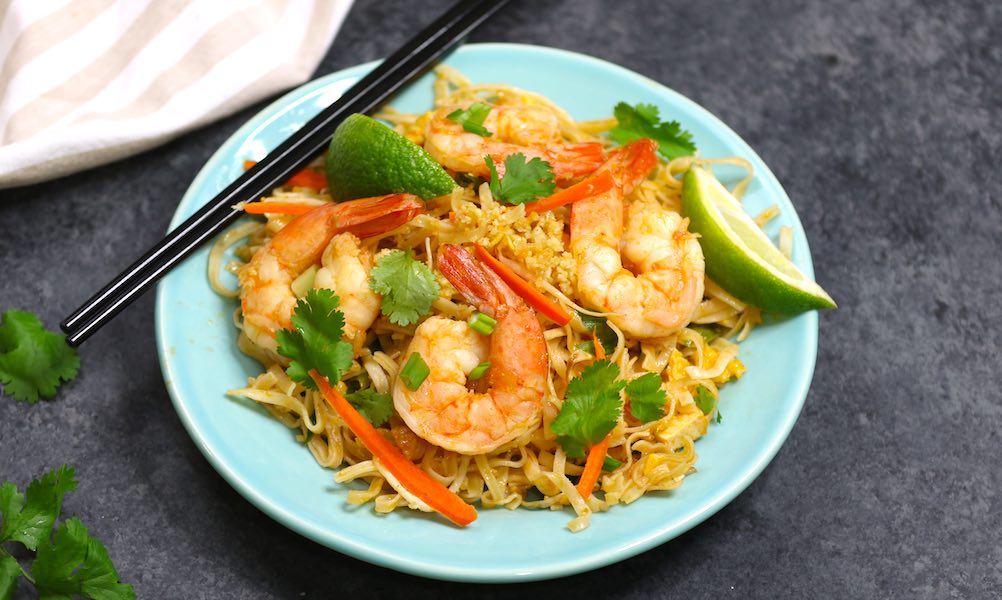
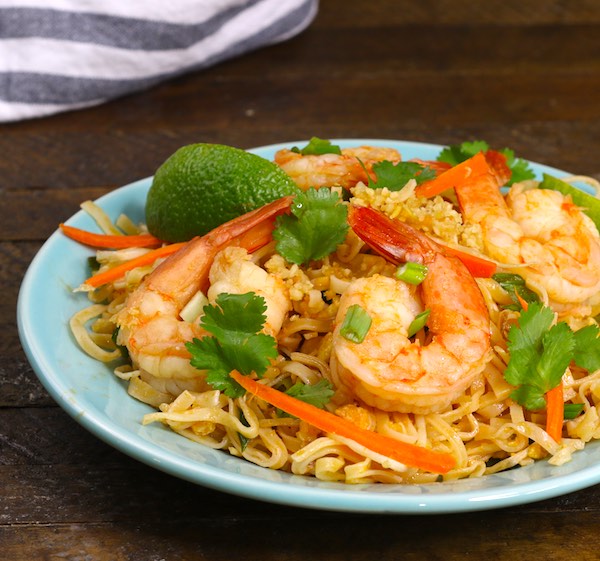
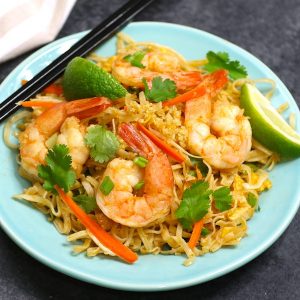
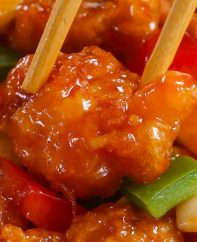

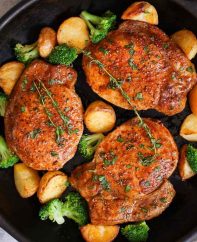
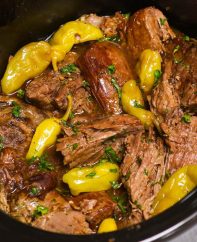
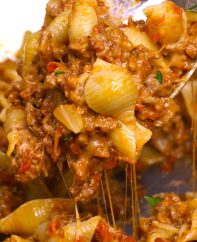
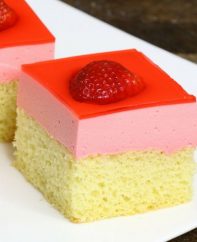

Made this for dinner last night. It was so easy and so good! Will definitely make again.
Hi Jenni, Thanks for letting me know and glad to hear it turned out well!